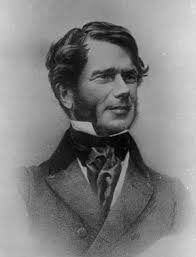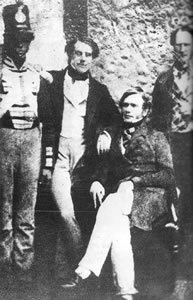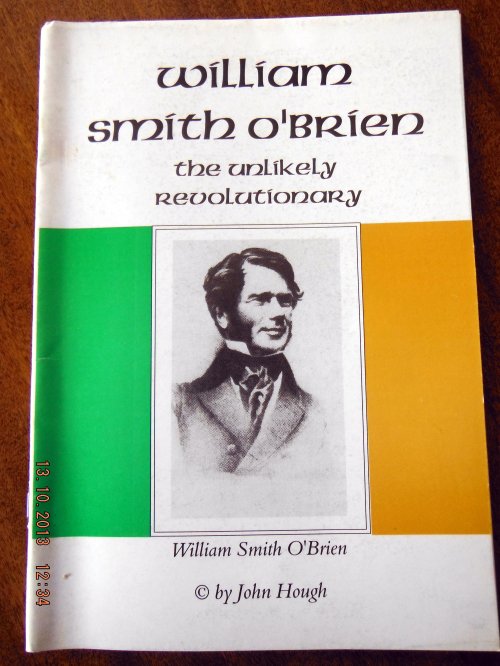 The anniversary of the birth of William Smith O’Brien, Young Irelander, is an appropriate time to record his strong association with the area in which I live in County Limerick, Ireland.
The anniversary of the birth of William Smith O’Brien, Young Irelander, is an appropriate time to record his strong association with the area in which I live in County Limerick, Ireland.
William O’Brien was born on 17 October 18o3, second son to Sir Edward O’Brien, Baron Inchiquin of Dromoland Castle, Member of Parliament for Ennis, County Clare and Charlotte Smith, daughter of the wealthy William Smith, an attorney,of Newcastle West, County Limerick. The O’Briens had accumulated large debts and the marriage to a wealthy Smith was a fortuitous one. Cahermoyle House, in Ardagh, Co Limerick was a property acquired by William Smith. William O’Brien (as he then was) inherited Cahermoyle House and lands of about 5,000 acres from his grandfather William Smith, and in honour of his grandfather, he adopted his name and from now on became known as William Smith O’Brien.
William Smith O’Brien followed in his father’s footsteps and entered politics, becoming conservative member of Parliament for Ennis from 1828 to 1831, but gave it up on his marriage to Lucy Gabbett from Limerick in 1832. The newly weds decided to make Cahermoyle House their home. Their marriage was a happy one and they had 7 children. William returned to politics and became Member of Parliament for Limerick County from 1835 to 1848.
At the House of Commons, Smith O’Brien vociferously highlighted the suffering of the people of Ireland, calling for better government and an end to Catholic discrimination. (The Famine was raging in Ireland between 1845 & 1852). He worked for Famine Relief Schemes and was Chairman of the Newcastle West Board of Guardians.

The house at Ballingarry, Co Tipperary, scene of the ill-fated Young Irelander Rebellion of 1848, led by William Smith O’Brien. Image Damian Shiels
He joined the Young Ireland Movement, and was arrested for ‘seditious conspiracy’ in 1848. Whilst on bail, he led the failed Rebellion at Ballingarry Co Tipperary later in 1848 and was arrested at Thurles Railway Station when making his way back to Cahermoyle. Smith O’Brien with Terence McManus, Patrick O’Donohoe and Thomas Francis Meagher were charged with high treason and on 9 October 1948 they were sentenced to death. A petition for clemency was raised, and contained 80,000 signatures. The sentences were commuted to transportation for life and on 9 July 1849 the Young Irelanders were transported to Van Diemen’s Land on board ‘The Swift’

Thomas Francis Meagher & William Smith O’Brien with a guardsman and gaoler in Tasmania. Image Wikimedia Commons
In 1854, O’Brien was pardoned and returned to Europe, but it was not until 1856 that he was permitted to return to Ireland and Cahermoyle, and to his much loved wife. Lucy died in 1861 and William was said to have been distraught. On 18 June 1864, William Smith O’Brien died whilst travelling in Bangor, North Wales. News of his death was reported across the world. His body was brought by ship from Wales to Dublin, arriving at the quayside in the very early hours of the morning.
The Sydney Morning Herald on 15 August reported on the funeral:
”The remains of the deceased arrived on the morning of the 23rd, at the North Wall, in the City of Dublin. About 2,000 persons were present to receive the remains. A hearse was in attendance,and as soon as the coffin was conveyed on shore it was borne towards the hearse in order to be conveyed to the Great Southern and Western Railway, en route to Cahermoyle, Limerick, but the people shouted, unanimously that it should be carried to the railway, and all efforts to take it to the hearse were unavailing. A procession was formed, and the coffin was borne on the shoulders of six men to the railway, by way of the Royal Canal and the principal streets. The green flag was waved over the remains before the train started for Cahermoyle.”
The body was transported by road from Limerick railway station,to repose at Cahermoyle before the funeral to the church at Rathronan, where the family worshipped. The vast funeral procession comprised a large number of gentry, some 20 catholic priests and hundreds of tenants, many mounted. It is said that the hearse had reached the church while the rear was still leaving Cahermoyle, some 2 miles away.
CAHERMOYLE TODAY
Cahermoyle House is now a Nursing Home, having previously been a catholic novitiate for the Oblate Fathers who had bought the house from the Smith O’Briens. It has been renovated and extended for its new incarnations, yet still remains and imposing and beautiful house. It has a particular link to my family as my mother spent her final 6 weeks there as a patient in 1999 and in 2006 my father died in the house, while in respite care. Both of them made their final journeys down the long avenue and through these gates.
On Sunday last, having read about the extraordinary reception of the coffin at the Dublin docks and the crowds that thronged the funeral, I went to the small graveyard at Rathronan, just about a mile from where I live. The now derelict church is a short distance off the main road, up a single track. The graveyard gate squeaked as I opened it,warning all those within that someone was coming! The peace of an early autumn Sunday afternoon was enhanced by a solitary bird singing high up in the trees, otherwise the silence was total.
The Smith O’Brien family mausoleum is an imposing and beautiful structure in this small graveyard. There are very few headstones here, in this exquisitely peaceful setting. The mausoleum was erected by Smith O’Brien’s son some two years after his father’s death. The door was open, but I did not venture in, and instead sat a while on the plinth thinking of the man and his family who rested inside. A great Irishman, a man of peace,an international figure of renown who sacrificed much for the people of Ireland and for a poor and downtrodden people of a religion not his own.
This post is not an historic review of the life of William Smith O’Brien, but rather a personal journey from his home to his final resting place. I am most grateful to a local historian Mr John Hough, author of ‘William Smith O’Brien – the unlikely Revolutionary’ for giving me a copy of his excellently researched and written pamphlet which records and recounts the events of the extraordinary life of this man of integrity and principle.
There is a statue of William Smith O’Brien in O’Connell Street, Dublin. originally erected at the junction of Sackville and D’Olier Streets in 1867, it was relocated to O’Connell Street in 1929. This monument to this extraordinary Irishman was the first statue erected in Dublin to commemorate an individual who had stood for armed resistance to British rule.

*** I am grateful to Kasia Gmerek for the following information by email:
The poem engraved there was The House, written by Charlotte Grace O’Brien’ William’s
daughter, and can be found in the volume published by her nephew Stephen Gwynn, see
here a digitized copy of the book:
http://archive.org/details/charlottegraceob00obriiala
References
Sydney Morning Herald 15 Aug 1864
http://landedestates.nuigalway.ie
The William Smith O’Brien Petition
www.dublincity.ie/SiteCollectionDocuments/history_monuments_oconnell_sthttp://www.limerickcity.ie/media/Smith%20O’Brien1.pdf




















Thank you for taking us on this somewhat personal journey. i have read several stories regarding William Smith O’Brien… an interesting man, but none have been so personal. I loved the photos, especially when I discovered they had captions.
Thanks very much Chris – and as ever thank you for dropping by 🙂 I have applied captions to the earlier photos now too!
Fascinating history! I like visiting old cemeteries.
Thank you ! There is something about old graveyards — I suppose we will all end up in one! This is a lovely little churchyard with very few graves visible. It was a delight to be in – just myself and that singing bird, high up in the tree. Your visit and comment are so very appreciated – thank you
Beautifully written Angela… thankyou. I gasped and my eyes filled with tears when reading…
“but the people shouted, unanimously that it should be carried to the railway, and all efforts to take it to the hearse were unavailing. A procession was formed, and the coffin was borne on the shoulders of six men to the railway, by way of the Royal Canal and the principal streets. The green flag was waved over the remains before the train started for Cahermoyle.”
:moving:
My youngest son will be delighted to read this touching personal account. Thanks again.
Thank YOU so much for such a lovely comment. We are surrounded by links to times past. I love it when we can cross the decades AND the religious divide – a divide that has not always been easily crossed in Ireland. It is such a pity that the inscriptions in this lovely little secluded graveyard are falling prey to the ravages of time and weather. I hope your son enjoys the post. 🙂 Your comments are so very much ppreciated
Interesting and very well recounted story SV. it’s a pity that Ireland’s old graveyards are often neglected and those interred are finally forgotten as the inscriptions fade. Surely there must have been more burials at Rathronan? Did someone remove the headstones for some reason?
Thank you. I first visited this little graveyard about 30 years ago – then it was totally overgrown. On my 2nd visit last week, the grass had been cut in recent weeks. The inscriptions are fading indeed – the Smith O’Brien ones were so poor that my basic camera could not pick them up. However, I have contacted Historicgraves.ie and they hope to visit early November. I would imagine that there was never a huge number of worshippers at this small Church of Ireland church, and therefore never a huge number of families who would be buried here. I am doing some more research on it as I am keen to find out. There were very few standing gravestones. I saw two flat ones about 30%covered by grass, but I don’t think there are any/many unmarked graves as the terrain was relatively flat. There were about a half dozen small stones that may have been grave markers with no names. It is an unfortunate thing that with the small numbers of non-catholic families, many of these beautiful and historic little churches are falling into ruin and the graveyards are neglected. One thing about Rathronan that stood out was that there was a grave there that had the brightest red geranium growing on it, so someone is minding it. Thanks for dropping by.
SV, thanks for such a sensitively written and insightful post. It was like you took me by the hand on this journey.
Thank you so much and thank you for dropping by!
Very interesting and fascinating… 🙂
Thank you – glad you found it so . Your visit is appreciated .
What a fascinating read and thank you so much for this. For me personally, it is wonderful to read about other people who make the time to explore the histories that are all around us and when that history overlaps with our own, it makes the read even more personal.
In a world where details and facts are important the relevancy of the personal details are often over looked. It is too easy to forget that we walk on the same land that people made such sacrifices for. Thank you again for this timely reminder.
Thank you so much for your kind remarks. I love to look for a connection back to historic events and people. I did not have to look very far with this one as I had spent many hours inside that house with my parents. William Smith O’Brien was indeed an unlikely revolutionary coming as he did from the landed gentry class.
Thank you so much for dropping by – it is very much appreciated.
After reading your lovely comment on my blog, I had to come over and visit. Your writing and photos, brought this fascinating story to life.
Hi Jill.
Thank you indeed for dropping by!
I heard about the O’Brien’s and their strong connection to the area when I visited the Cliffs of Moher, but I didn’t get the full story until I read this post. Thanks!
There is indeed a lot of O’Brien influence in Clare and at the beautiful Cliffs of Moher. I am not sure whether or not the O’Brien of the tower at the cliffs (Cornelius) is related to William Smith O ‘Brien, who is also from Co Clare.
Thank you so much for dropping by 🙂
What a man! You must be so proud. I come from the other end of the Irish uprising with quite a few of my Australian convict ancestors being Irish Defenders. So it’s nice to say a hello from DownUnder in more than one sense of the word 🙂
Hi Kim. How interesting – who were your ancestors and what did they do? I love the connection between our countries and the huge sense of Irish history that resides down there. Thank you so much for dropping by – very much appreciated.
Wow. What a great legacy, testimony, and post about a journey of being a good man with courage and conviction. I’m going to reblog this, since my blog is about wilder men. You may find this interesting (but maybe not) … I am doing another one of my stories in November (w- a live audience). This one is about a guy named Zebulon Pike, born in 1779 … died in battle in 1813. But his story and legacy doesn’t even compare with Mr. O’Brien’s.
Thank you – I am glad you were impressed by William Smith O’Brien – he was an impressively courageous man of principle. I am hoping that you will let us us have a bio -blog on the fantastically named Zebulon Pike! Thanks for dropping by!
Reblogged this on Wilder Man On Rolling Creek and commented:
Hey, Folks: I try to bring a post in, from time to time, about a good man who I would consider to be a “Wilder Man”. This is a great story about a courageous Irish sojourner. I hope you enjoy. The pictures are pretty incredible. Peace, T
Thank you so much for reposting my blog 🙂
Oh, I love this. You did a terrific job of rescuing this man from the dim distant recesses of my memory. Great photos too. I especially love that you went to the family grave to pay your own tribute to this hero. Coming back to read it again the day`s work is done. Well done, SV, encore! encore!
Oh thanks you so much for such a delightful comment! You made my day!
Thank you, Angela. I appreciate this glimpse into one of your lovely journeys. I recommend the book “William Smith O’Brien and His Irish Revolutionary Companions in Penal Exile,” by Blanche M. Touhill. Would like to repost this on my blog if that’s OK with you. Wishing you well, Janet
Thank you Janet – I must check out the book – and feel free to repost – thank you very much 🙂 . Best regards Angela
Reblogged this on Maher Matters and commented:
In 1848 William Smith O’Brien, along with Thomas Francis Meagher, Terence Bellew McManus, and Patrick O’Donoghue, leaders among the Young Irelanders, were “sentenced to be hanged, drawn and quartered, and [their] remains placed at the disposal of her majesty the Queen, to be dealt with according to her royal pleasure…The men’s verdicts were commuted to the more usual ‘transportation for life’ to Van Dieman’s Island/Tasmania, Australia, from which, with the help of others, Meagher escaped to America in 1852…” (From the Old Sod to the Naugatuck Valley, pp. 63, 64). I recommend Blanche M. Touhill’s book, “William Smith O’Brien and His Irish Revolutionary Companions in Penal Exile,” and John Martin’s “Jail Journal (or Five Years in British Prisons,” along with this blog post.
A Silver Voice from Ireland has written here about her visit to William Smith O’Brien’s former home in County Limerick and recounted his role in Irish history as a dedicated supporter of those discriminated against by the British monarchy. She included a great image of Meagher and O’Brien with their jailor in Tasmania.
Also see the “Release of Mrs. Meagher, Ballingarry,” in which an episode almost forty years later was reported, as one Mrs. Meagher was “released from Waterford Jail, after spending a term of three weeks for the great crime of being found walking or standing on the lands from which she and her husband were unjustly evicted by their landlord, Michael Morris, JP., coal merchant, Fiddown…” (http://ballingarry.net/people/mrsmeagher.html)
Really nice read!
Cheers Diarmaid. Glad you enjoyed and thanks for dropping by
paid a visit to rathronan yesterday a little jaded and neglected what a pity
Hi. Sadly it is rather neglected. The grass is cut once or twice a year and that is the extent of it. The church is used as a store by the county council as far as I know. It is such a shame that an important site is in this state.
Pingback: Postcards from Ardagh, County Limerick – a hidden Ireland | A SILVER VOICE FROM IRELAND
Pingback: DUBLIN, 1920 : THE ‘TWELVE APOSTLES’ CAME KNOCKING… | 11sixtynine